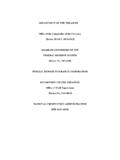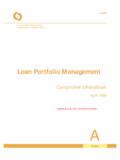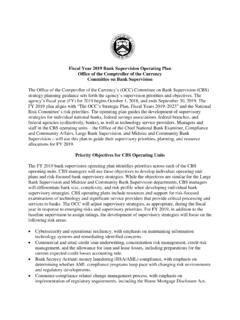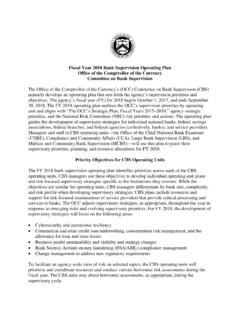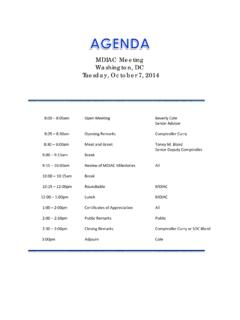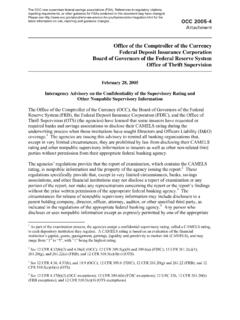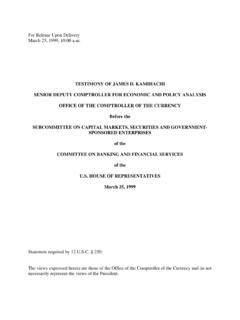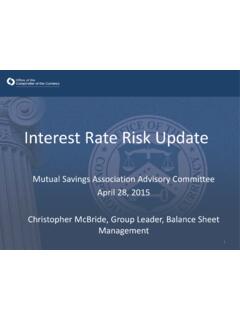Transcription of Flood Disaster Protection Act
1 Interagency Consumer Laws and Regulations FDPA August 2019 FDPA 1 Flood Disaster Protection Act The National Flood Insurance Program (NFIP) is administered primarily under the National Flood Insurance Act of 1968 (1968 Act) and the Flood Disaster Protection Act of 1973 (FDPA).1 The 1968 Act made federally subsidized Flood insurance available to owners of improved real estate or mobile homes located in special Flood hazard areas (SFHA) if their community participates in the NFIP. The NFIP, administered by a department of the Federal Emergency Management Agency (FEMA) known as the Federal Insurance and Mitigation Administration (FIMA), makes federally backed Flood insurance available to consumers through NFIP Direct Program agents who deal directly with FEMA or through the Write Your Own Program (WYO), which allows consumers to purchase federal Flood insurance from private insurance carriers.
2 The NFIP aims to reduce the impact of flooding by providing affordable insurance to property owners and by encouraging communities to adopt and enforce floodplain management regulations. The FDPA requires federal financial regulatory agencies to adopt regulations prohibiting their regulated lending institutions from making, increasing, extending or renewing a loan secured by improved real estate or a mobile home located or to be located in an SFHA in a community participating in the NFIP unless the property securing the loan is covered by Flood insurance.
3 Flood insurance may be provided through the NFIP or through a private insurance carrier. Title V of the Riegle Community Development and Regulatory Improvement Act of 1994,2 which is called the National Flood Insurance Reform Act of 1994 (1994 Act), comprehensively revised the Federal Flood insurance statutes. The purpose of the 1994 Act was to i nc rease compliance with Flood insurance requirements a nd participation in the N FIP in order to provide additional i nc ome to t he National F lood Insurance Fund and to decrease t he financial burden of flooding on the Fede ral government, ta xpayers, a nd Flood The 1994 Act r equired t he fede ral f inancial regulat ory agencies, the Board of Governors of the Federal Reserve System (FRB); the Federal Deposit Insurance Corporation (FDIC); the National Credit Union Administration (NCUA).
4 And the Office of the Comptroller of the Currency (OCC) to r evi se t heir current f lood insurance regulations a nd brought lenders regulated by the Farm Credit Admini strati on (FCA) under the coverage of the Federal Flood insurance statutes. The federal financial regulatory age ncies and the FCA (collectively, the Agencies) jointly issued regulations on August 29, 1996 (61 FR 45684).4 The 1994 Act also made the Flood insurance requirements directly applicable to the loans purchased by the Federal National Mortgage Association (Fannie Mae) and the Federal Home Loan Mortgage Corporation (Freddie Mac) and to agencies that provide government insurance or 1 These statutes are codified at 42 USC 4001-4129.
5 FEMA administers the NFIP; its regulations implementing the NFIP appear at 44 CFR Parts 59-80. 2 Pub. , Title V, 108 Stat. 2160, 2255-87 (September 23, 1994). 3 Conf. Rep. No. 652, 103d Cong. 2d Sess. 195 (1994). (Conference Report). 4 Agency regulations are codified at 12 CFR 22 (OCC); 12 CFR 208 (FRB); 12 CFR 339 (FDIC); 12 CFR 614 (FCA); 12 CFR 760 (NCUA). Interagency Consumer Laws and Regulations FDPA August 2019 FDPA 2 guarantees such as the Small Business Administration (SBA), Federal Housing Administration (FHA), and the Department of Veterans Affairs (VA).
6 The mandatory Flood insurance purchase requirements of the FDPA were again significantly amended with the passage of the Biggert-Waters Flood Insurance Reform Act of 2012 (Biggert-Waters Act) and the Homeowner Flood Insurance Affordability Act of 2014 (HFIAA). These statutes made changes to the provisions pertaining to force placement of Flood insurance; escrowing of Flood insurance premiums and fees; exemptions to the mandatory Flood insurance purchase requirement; and civil money penalties. Moreover, a new provision mandating the acceptance of a private Flood insurance policy meeting certain criteria as satisfaction of the mandatory purchase requirement was added to the FDPA.
7 The Agencies jointly issued rules addressing force placement, escrow, and the exemption to the mandatory purchase requirement for detached structures on July 21, 2015 (80 FR 43215). The Agencies jointly issued rules implementing the private Flood insurance provisions of the Biggert-Waters Act on February 20, 2019 (84 FR 4953). Objectives of the FDPA: Provide Flood insurance to owners of improved real estate located in SFHAs of communities participating in the NFIP. Require communities to enact measures designed to reduce or avoid future Flood losses as a condition for making federally subsidized Flood insurance available.
8 Require federal financial regulatory agencies to adopt regulations prohibiting their regulated lending institutions from making, increasing, extending, or renewing a loan secured by improved real estate or a mobile home located or to be located in an SFHA of a community participating in the NFIP, unless the property securing the loan is covered by Flood insurance. Require federal agencies, such as the FHA, SBA and the VA not to subsidize, insure, or guarantee any loan if the property securing the loan is in an SFHA of a community not participating in the NFIP.
9 Structures Eligible for Flood Insurance Under the NFIP The NFIP covers improved real property or mobile homes located or to be located in an area identified by FEMA as having special Flood hazards. Generally, each insurable structure requires a separate insurance policy. The following types of structures are eligible for coverage: Residential, industrial, commercial, and agricultural buildings that are walled and roofed structures that are principally above ground. Buildings under construction where a development loan is made to construct insurable improvements on the land.
10 Insurance can be purchased to keep pace with the new construction. Interagency Consumer Laws and Regulations FDPA August 2019 FDPA 3 Mobile homes that are affixed to a permanent site, including mobile homes that are part of a dealer s inventory and affixed to permanent foundations. Condominiums. Co-operative buildings. Flood insurance coverage is also available for personal property and other insurable contents contained in real property or mobile homes located in SFHAs. The property must be insured in order for the contents to be eligible. Structures Not Eligible for Flood Insurance Under the NFIP Unimproved land, bridges, dams, and roads.
